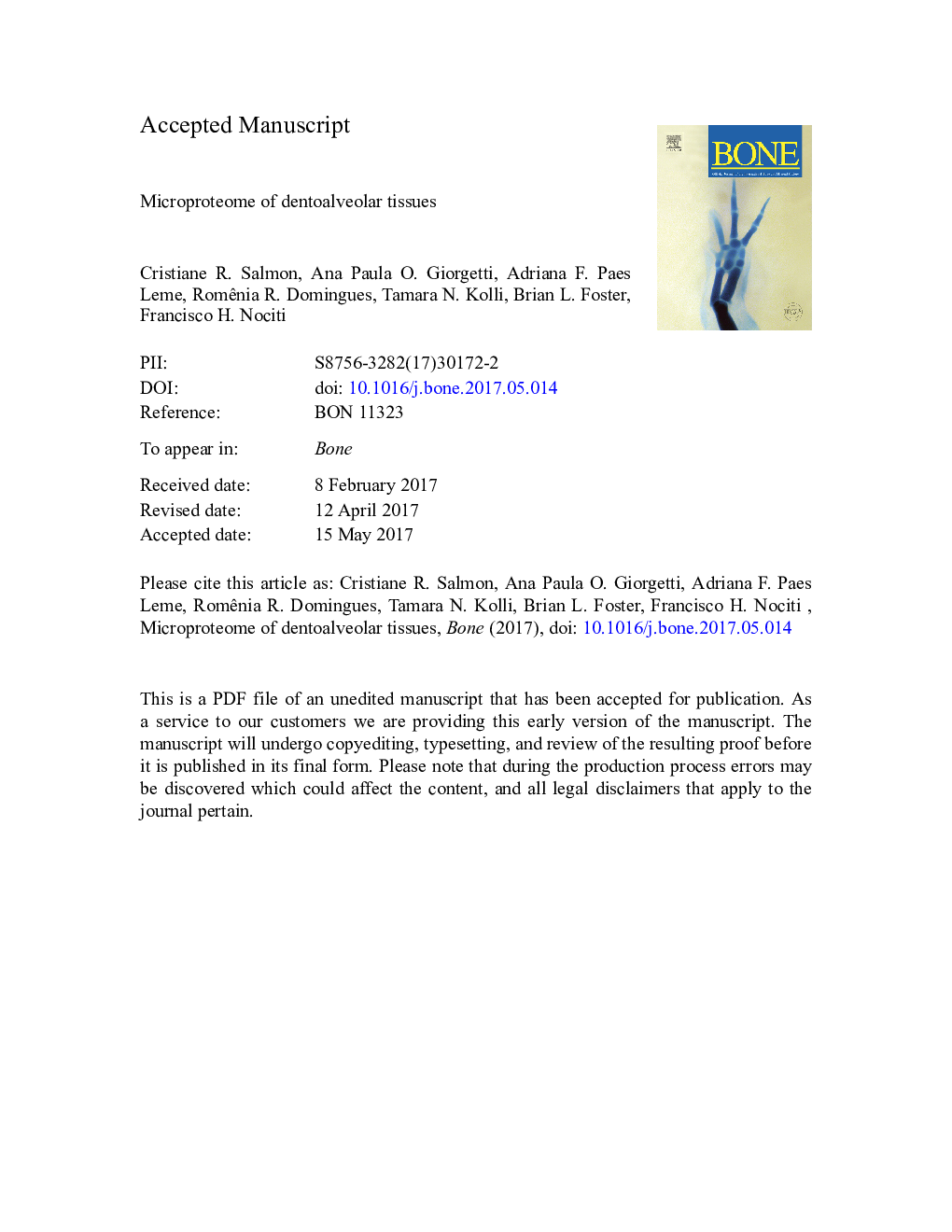| Article ID | Journal | Published Year | Pages | File Type |
|---|---|---|---|---|
| 5585226 | Bone | 2017 | 46 Pages |
Abstract
Proteomic analysis of extracellular matrices (ECM) of dentoalveolar tissues can provide insights into developmental, pathological, and reparative processes. However, targeted dissection of mineralized tissues, dental cementum (DC), alveolar bone (AB), and dentin (DE), presents technical difficulties. We demonstrate an approach combining EDTA decalcification and laser capture microdissection (LCM), followed by liquid chromatography coupled to tandem mass spectrometry (LC-MS/MS), to analyze proteome profiles of these tissues. Using the LCM-LC-MS/MS approach, a total of 243 proteins was identified from all tissues, 193 proteins in DC, 147 in AB, and 135 proteins DE. Ninety proteins (37% of total) were common to all tissues, whereas 52 proteins (21%) were overlapping in only two. Also, 101 (42%) proteins were exclusively detected in DC (60), AB (15), or DE (26). Identification in all tissues of expected ECM proteins including collagen alpha-1(I) chain (COL1A1), collagen alpha-1(XII) chain (COL12A1), biglycan (BGN), asporin (ASPN), lumican (LUM), and fibromodulin (FMOD), served to validate the approach. Principal component analysis (PCA) and hierarchical clustering identified a high degree of similarity in DC and AB proteomes, whereas DE presented a distinct dataset. Exclusively and differentially identified proteins were detected from all three tissues. The protein-protein interaction network (interactome) of DC was notable for its inclusion of several indicators of metabolic function (e.g. mitochondrial proteins, protein synthesis, and calcium transport), possibly reflecting cementocyte activity. The DE proteome included known and novel mineralization regulators, including matrix metalloproteinase 20 (MMP-20), 5â² nucleotidase (NT5E), and secreted phosphoprotein 24 (SPP-24 or SPP-2). Application of the LCM-LC-MS/MS approach to dentoalveolar tissues would be of value in many experimental designs, including developmental studies of transgenic animals, investigation of treatment effects, and identification of novel regenerative factors.
Keywords
BGNACO2TGF-βAEC3-amino-9-ethylcarbazoleSLRPBiglycanMmp-20ASPNCOL1A1PDLXLHOdontogenesisDSPPMGPOPNAHSGSPARCDMP1MEPEX-linked hypophosphatemiaALPLSmall Integrin-Binding LIgand N-linked GlycoproteinVIMPHEXAsporinFbn2fibrillin-2fmodVimentinABCECMBMP2DCNIBSPACDCPBSaconitate hydrataseUQCRC1LCMHADHBUQCRC2LC-MS/MSFFPEPCATissue-nonspecific alkaline phosphataseOsteopontinBoneAlveolar boneUltravioletIHCImmunohistochemistryTransforming Growth Factor BetaProtein ANalysis THrough Evolutionary RelationshipsPrincipal component analysisHADHASiblingPENdecorinPeriodontal ligamentdentin sialophosphoproteindental cementumDentinActbmatrix extracellular phosphoglycoproteinFibromodulinlumLumicanlaser capture microdissectionExtracellular matrixInfraredPhosphate-buffered salineprincipal componentGene ontologyformalin-fixed paraffin embeddedPANTHERProteomicssmall leucine-rich proteoglycansecreted protein acidic and rich in cysteineMatrix Gla proteindentin matrix protein 1bone morphogenetic protein 2PeriostinPostnPolyethylene naphthalateliquid chromatography coupled to tandem mass spectrometry
Related Topics
Life Sciences
Biochemistry, Genetics and Molecular Biology
Developmental Biology
Authors
Cristiane R. Salmon, Ana Paula O. Giorgetti, Adriana F. Paes Leme, Romênia R. Domingues, Tamara N. Kolli, Brian L. Foster, Francisco H. Jr.,
